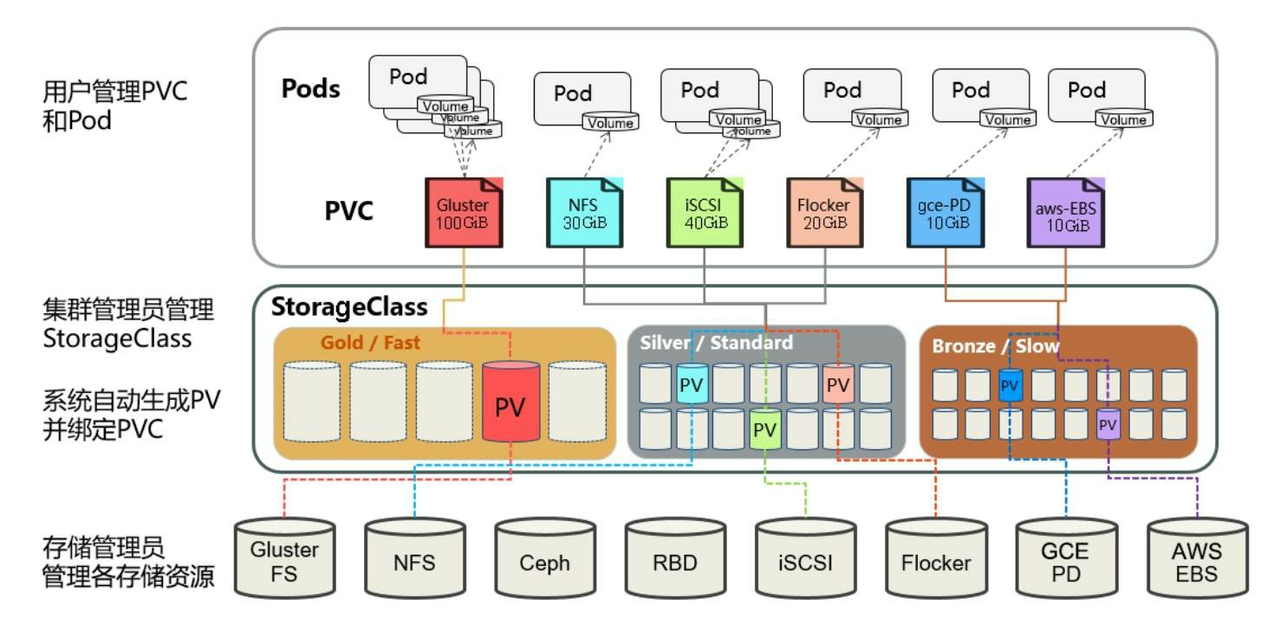emptyDir临时卷
有些应用程序需要额外的存储,但并不关心数据在重启后仍然可用。
例如,缓存服务经常受限于内存大小,将不常用的数据转移到比内存慢、但对总体性能的影响很小的存储中。
再例如,有些应用程序需要以文件形式注入的只读数据,比如配置数据或密钥。
临时卷就是为此类用例设计的。因为卷会遵从 Pod 的生命周期,与 Pod 一起创建和删除, 所以停止和重新启动 Pod 时,不会受持久卷在何处可用的限制。
下面我们就通过一个临时卷,让一个pod中的两个容器实现文件共享。
apiVersion: v1 kind: Pod metadata: name: emptydirpod namespace: chesterns spec: containers: - name: writeinfo image: centos command: ["bash","-c","for i in {1..100};do echo $i >> /data/hello;sleep 1;done"] volumeMounts: - name: data mountPath: /data - name: readinfo image: centos command: ["bash","-c","tail -f /data/hello"] volumeMounts: - name: data mountPath: /data volumes: - name: data emptyDir: {}
验证
kubectl exec emptydirpod -c readinfo -n chesterns -- cat /data/hello
hostPath卷
挂载Node文件系统(Pod所在节点)上文件或者目录到Pod中的容器。通常用在Pod中容器需要访问宿主机文件的场景下。
下面通过一个yaml来实现hostPath卷
apiVersion: v1 kind: Pod metadata: name: hostpathpod namespace: chesterns spec: containers: - name: busybox image: busybox args: - /bin/sh - -c - sleep 36000 volumeMounts: - name: data mountPath: /data volumes: - name: data hostPath: path: /tmp type: Directory
验证
kubectl apply -f hostpath.yaml
kubectl exec hostpathpod -n chesterns -- ls /datals /tmp
网络卷NFS
NFS是一个主流的文件共享服务器。可以实现分布式系统中的文件统一管理。
yum install nfs-utils -y #每个Node上都要安装nfs-utils包
master上开启nfs-server
#master vi /etc/exports /tmp/chesternfs *(rw,fsid=0,no_root_squash) mkdir -p /tmp/chesternfs systemctl start nfs systemctl enable nfs
定义一个deployment,使用我们刚搭建的nfssever来挂载文件
apiVersion: apps/v1 kind: Deployment metadata: name: nfsdeployment namespace: chesterns spec: selector: matchLabels: app: nginx replicas: 3 template: metadata: labels: app: nginx spec: containers: - name: nginx image: nginx volumeMounts: - name: wwwroot mountPath: /usr/share/nginx/html ports: - containerPort: 80 volumes: - name: wwwroot nfs: server: 192.168.43.111 path: /tmp/chesternfs
通过新建一个a.html来验证是不是挂载进了容器
vi /tmp/chesternfs/index.html/a.html kubectl get pod -n chesterns kubectl exec nfsdeployment-f846bc9c4-s2598 -n chesterns -- ls /usr/share/nginx/html curl 10.244.36.122/a.html
PV与PVC
我们可以将PV看作可用的存储资源,PVC则是对存储资源的需求,PV与PVC是为了方便我们对存储资源进行系统的管理而诞生的,有了pv和pvc我们就可以对我们所有的存储资源进行合理的分配。
pv的创建又分为静态模式与动态模式。
静态模式
集群管理员手工创建许多PV,在定义PV时需要将后端存储的特性进行设置。

定义PV,声明需要5g空间
apiVersion: v1 kind: PersistentVolume metadata: name: chesterpv namespace: chesterns spec: capacity: storage: 5Gi accessModes: - ReadWriteMany nfs: path: /tmp/chesternfs server: 192.168.43.111
AccessModes(访问模式):
-
ReadWriteOnce(RWO):读写权限,但是只能被单个节点挂载
-
ReadOnlyMany(ROX):只读权限,可以被多个节点挂载
-
ReadWriteMany(RWX):读写权限,可以被多个节点挂载
RECLAIM POLICY(回收策略):
通过pv的persistentVolumeReclaimPolicy字段设置
-
Retain(保留):保留数据,需要管理员手工清理数据
-
Recycle(回收):清除 PV 中的数据,等同执行 rm -rf /tmp/chesternfs/*
-
Delete(删除):与 PV 相连的后端存储同时删除
应用pv
kubectl apply -f pv.yaml
kubectl describe pv chesterpv -n chesterns
PVSTATUS(状态):
-
Available(可用):表示可用状态,还未被任何 PVC 绑定
-
Bound(已绑定):表示 PV 已经被 PVC 绑定
-
Released(已释放):PVC 被删除,但是资源还未被集群重新声明
-
Failed(失败):表示该 PV 的自动回收失败
下面我们定义pvc,设置一样的存储空间,绑定刚刚建好的pv
apiVersion: v1 kind: PersistentVolumeClaim metadata: name: chesterpvc namespace: chesterns spec: accessModes: - ReadWriteMany resources: requests: storage: 5Gi
应用pvc
kubectl apply -f pvc.yaml kubectl describe pvc chesterpvc -n chesterns kubectl describe pv chesterpv -n chesterns
使用PVC,我们定义一个pod,指定挂载用的pvc
apiVersion: v1 kind: Pod metadata: name: chesterpvcpod namespace: chesterns spec: containers: - name: nginx image: nginx:latest ports: - containerPort: 80 volumeMounts: - name: www mountPath: /usr/share/nginx/html volumes: - name: www persistentVolumeClaim: claimName: chesterpvc
通过以下命令应用,并验证
kubectl apply -f pvcpod.yaml kubectl describe pod chesterpvcpod -n chesterns kubectl describe pvc chesterpvc -n chesterns kubectl describe pv chesterpv -n chesterns curl 10.244.36.123/a.html
动态模式
动态模式可以解放集群管理员,集群管理员无须手工创建PV,而是通过StorageClass的设置对后端存储进行描述,标记为某种类型。此时要求PVC对存储的类型进行声明,系统将自动完成PV的创建及与PVC的绑定。PVC可以声明Class为"",说明该PVC禁止使用动态模式。

K8s需要安装插件支持NFS动态供给。
项目地址:https://github.com/kubernetes-sigs/nfs-subdir-external-provisioner/tree/master/deploy
下载并安装,需要修改其中的namespace为我们自己的chesterns
kubectl apply -f nfs-rbac.yaml # 授权访问apiserver kubectl apply -f nfs-deployment.yaml # 部署插件,需修改里面NFS服务器地址与共享目录 kubectl apply -f nfs-class.yaml # 创建存储类
下面我们定义pvc绑定我们刚建的storageclass,并且新建一个pod使用我们新建的这个pvc
apiVersion: v1 kind: PersistentVolumeClaim metadata: name: chesterscpvc namespace: chesterns spec: storageClassName: "nfs-client" accessModes: - ReadWriteMany resources: requests: storage: 1Gi --- apiVersion: v1 kind: Pod metadata: name: chesterpvcscpod namespace: chesterns spec: containers: - name: chesterpvcscpod image: nginx volumeMounts: - name: nfs-pvc mountPath: "/usr/share/nginx/html" volumes: - name: nfs-pvc persistentVolumeClaim: claimName: chesterscpvc
验证
kubectl exec chesterpvcscpod -n chesterns -- touch /usr/share/nginx/html/aa
ll /tmp/chesternfs/
ConfigMap
ConfigMap 是一种配置资源,用来将非机密性的数据保存到etcd键值对中。使用时,Pods可以将其用作环境变量、命令行参数或者存储卷中的配置文件。
下面就来实现一个简单的ConfigMap使用案例
定义ConfigMap
apiVersion: v1 kind: ConfigMap metadata: name: game-demo namespace: chesterns data: # 类属性键;每一个键都映射到一个简单的值 player_initial_lives: "3" ui_properties_file_name: "user-interface.properties" # 类文件键 game.properties: | enemy.types=aliens,monsters player.maximum-lives=5 user-interface.properties: | color.good=purple color.bad=yellow allow.textmode=true
通过kubectl apply应用后,开始在pod中使用
apiVersion: v1 kind: Pod metadata: name: configmap-demo-pod namespace: chesterns spec: containers: - name: demo image: alpine command: ["sleep", "3600"] env: # 定义环境变量 - name: PLAYER_INITIAL_LIVES # 请注意这里和 ConfigMap 中的键名是不一样的 valueFrom: configMapKeyRef: name: game-demo # 这个值来自 ConfigMap key: player_initial_lives # 需要取值的键 - name: UI_PROPERTIES_FILE_NAME valueFrom: configMapKeyRef: name: game-demo key: ui_properties_file_name volumeMounts: - name: config mountPath: "/config" readOnly: true volumes: # 你可以在 Pod 级别设置卷,然后将其挂载到 Pod 内的容器中 - name: config configMap: # 提供你想要挂载的 ConfigMap 的名字 name: game-demo # 来自 ConfigMap 的一组键,将被创建为文件 items: - key: "game.properties" path: "game.properties" - key: "user-interface.properties" path: "user-interface.properties"
验证
kubectl apply -f configmap.yaml
kubectl apply -f configmappod.yaml
Secret
Secret 类似于ConfigMap但专门用于保存机密数据。下面定义一个secret
apiVersion: v1 data: username: YWRtaW4= password: MWYyZDFlMmU2N2Rm kind: Secret metadata: name: mysecret namespace: chesterns
应用secret
kubectl apply -f secret.yaml kubectl get secret -n chesterns
在Pod中使用Secret
apiVersion: v1 kind: Pod metadata: name: mypod namespace: chesterns spec: containers: - name: mypod image: redis volumeMounts: - name: foo mountPath: "/etc/foo" readOnly: true volumes: - name: foo secret: secretName: mysecret
验证
kubectl apply -f secretpod.yaml kubectl get pod -n chesternskubectl exec mypod -n chesterns -- ls /etc/foo